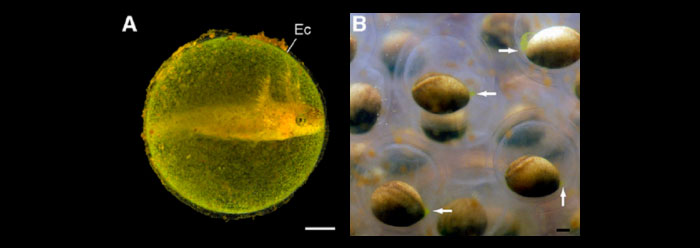Algal cells and cell parts are known to live inside the cells of an array of sea creatures, including certain sea slugs and jellyfish.1 Over 100 years ago, algae were found in association with certain salamander eggs, but their mode of living remained mysterious. Now, research shows that whole algal cells actually live inside some of the cell cytoplasm of developing salamanders, and the implications of this discovery are intriguing.
In a study published online in the Proceedings of the National Academy of Sciences, a team of biologists detected the tiny algal cells inside the salamander through fluorescence microscopy, a technique that uses certain light wavelengths to stimulate molecules that capture and transfer photons and electrons in living systems.2 The researchers found that algae had entered the developing salamanders after stage 17 of embryonic development.
Some algae were concentrated in the salamander embryo's gut cells. When the amphibians hatched to begin their aquatic life stage, these algae were expelled into the watery environment. Algae in some of the other tissues appeared to break up inside the cells by the time the salamanders were independently feeding.
How are the algae entering the embryonic cells? Do they hurt or harm the salamander? How and why do they leave the salamander as it matures? And what circumstances are required to make this whole system operate? The PNAS report only answered some of these questions.
The researchers compared salamanders with and without symbiotic algae and discovered that the algae actually help the salamanders. Those with algal infections matured faster, grew larger, hatched closer to the same time, and more of them hatched. The team also established that the algae also benefit, making the discovery of this arrangement one of "unanticipated complexity."2
One reason that this level of algae/salamander mutualism was not anticipated is because in order for the relationship to work, both the salamander and the algae must possess features that are "tuned" to the other organism's attributes. For example, the algae have to migrate away from their light energy source in order to seek out the eggs, which are typically laid in dark recesses. And the salamanders' immune systems must have a special ability to recognize the invading algae cells in order to avoid attacking them.
It is not yet known how the algae and salamander cells communicate, but similar symbiotic infections are mediated by specially designed biochemicals, some of which communicate by a precise lock-and-key fit.
But the fundamental reason why the researchers did not anticipate this complex interaction was because of their assumption that evolution is the source of any such "congruence between host and symbiont population structures."2 Without an intelligent God to have set up the precise arrangements between salamander and algae, one is left with merely natural processes to explain them—which, of course, they cannot.
This symbiotic relationship is best explained by a benevolent Creator. If the world and its living things are the product of an all-wise Designer, then one would anticipate the discovery in plants and animals of layers of complexity that defy all natural explanations.
References
- Sherwin, F. and B. Thomas. 2010. Are Green Sea Slugs the Ultimate Created Mosaic? Acts & Facts. 39 (3): 18.
- Kerney, R. et al. Intracellular invasion of green algae in a salamander host. Proceedings of the National Academy of Sciences. Published online before print April 4, 2011.
Image credit: Copyright © 2011 National Academy of Sciences. Adapted for use in accordance with federal copyright (fair use doctrine) law. Usage by ICR does not imply endorsement of copyright holders.
* Mr. Thomas is Science Writer at the Institute for Creation Research.
